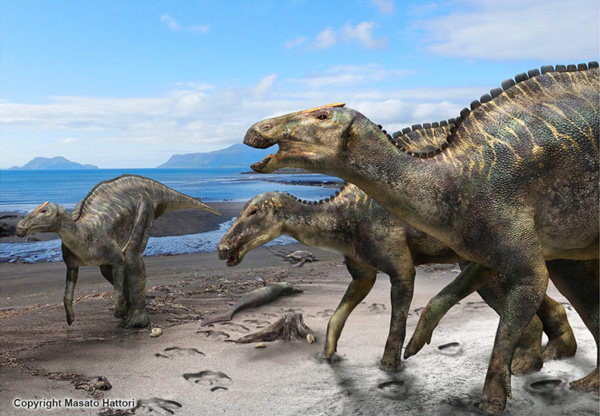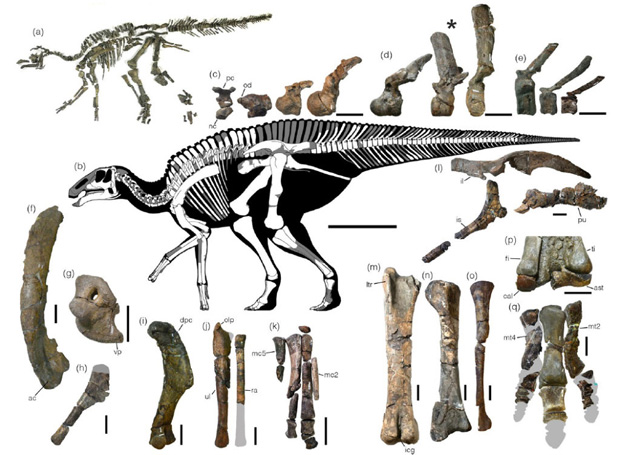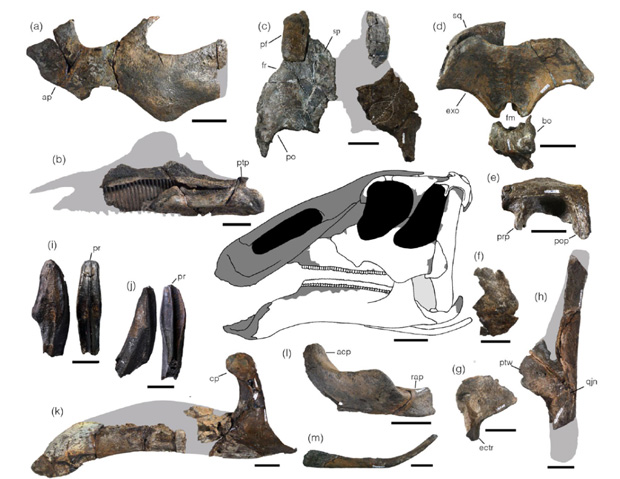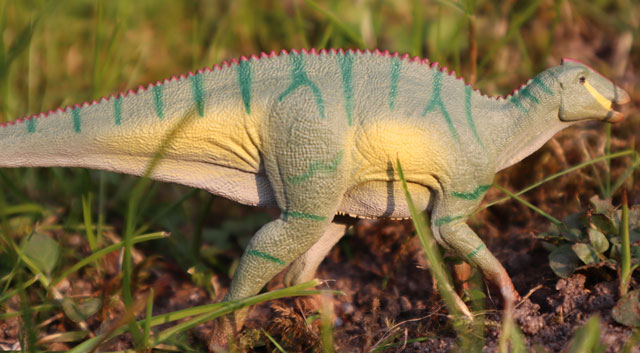Japan’s Greatest Fossil Dinosaur Gets a Name
Kamuysaurus japonicus – Japan’s Newest Dinosaur
Earlier this month, a scientific paper was published providing details of Japan’s most complete dinosaur fossil known to science. The dinosaur, a member of the Hadrosauridae, has been named Kamuysaurus japonicus, with the Rugby World Cup starting today in the “land of the rising sun”, we thought it appropriate to feature this new species of Late Cretaceous duck-billed dinosaur in today’s blog post.
A Life Reconstruction of the Newly Described Japanese Dinosaur Kamuysaurus japonicus

Picture credit: Kobayashi Y., et al, Scientific Reports
Kamuysaurus japonicus
The fossils come from the part Cretaceous to Palaeocene-aged Hakobuchi Formation, specifically from outcrops close to the town of Mukawa on the island of Hokkaido. Despite the semi-articulated and nearly complete nature of the fossil material, some bones are heavily damaged and show signs of extensive bioerosion (damage caused by marine invertebrates boring into the bones), prior to burial. The strata associated with the fossil material has yielded ammonites, mosasaurs and the remains of a sea turtle, it is correlated to the lowest Maastrichtian (faunal stage).
At Everything Dinosaur, we have followed the research into this new species of duck-billed dinosaur with eager anticipation. We first wrote about this fossil discovery some years ago, when tail bones discovered eroding out of a hillside hinted at a very special dinosaur fossil find: Japan’s Most Complete Dinosaur Discovery.
Assigned to the Edmontosaurini Clade
In the current study, a group of researchers led by Professor Yoshitsugu Kobayashi of the Hokkaido University Museum conducted comparative and phylogenetic analyses on 350 bones and 70 taxa of hadrosaurids, which led to the discovery that the dinosaur belongs to the Edmontosaurini clade and is closely related to Kerberosaurus unearthed in Russia and Laiyangosaurus from China. This herbivorous dinosaur was named after the indigenous people of Hokkaido, the specific name refers to Japan. It translates as “the deity of Japanese dinosaurs”.
The Holotype Skeleton of Kamuysaurus

Picture credit: Kobayashi Y., et al Scientific Reports
Unique Characteristics
The researchers found that Kamuysaurus has three unique characteristics that are not shared by other dinosaurs in the Edmontosaurini clade: the low position of the cranial bone notch, the short ascending process of the jaw bone, and the anterior inclination of the neural spines of the sixth to twelfth dorsal vertebrae. The histological analysis revealed that the animal was a fully grown adult at least nine years of age and it measured 8 metres in length with a body mass of around 4,000 kilograms.
The frontal bone, a part of its skull, has a big articular facet connecting to the nasal bone, possible evidence that Kamuysaurus may have had a crest. The crest, if it existed, is believed to resemble the thin, flat crest of Brachylophosaurus subadults, whose fossils have been unearthed in North America.
Selected Skull Elements of Kamuysaurus japonicus

Picture credit: Kobayashi Y., et al Scientific Reports
The Origins of the Edmontosaurini
The study also shed light on the origin of the Edmontosaurini clade and how it might have migrated. Its latest common ancestors spread widely across Asia and North America, which were connected by what is now Alaska, allowing them to travel between the two continents. Among them, the clade of Kamuysaurus, Kerberosaurus and Laiyangosaurus inhabited the Far East during the Campanian faunal stage, the fifth of six ages of the Late Cretaceous, before evolving independently.
CollectA have added a replica of this Japanese dinosaur to their Age of Dinosaurs model range.
The CollectA Age of Dinosaurs K. japonicus Figure

Picture credit: Everything Dinosaur
To view the CollectA prehistoric life model range: CollectA Age of Dinosaurs/Prehistoric Life Models.
Kamuysaurus a Creature of the Coast?
The research team’s analyses pointed to the possibility that ancestors of hadrosaurids and its subfamilies, Hadrosaurinae and Lambeosaurinae, preferred to inhabit areas near the ocean, suggesting the coastline environment was an important factor in the diversification of the hadrosaurids in its early evolution, especially in North America.
Everything Dinosaur acknowledges the assistance of a press release from Hokkaido University in the compilation of this article.
The “A New Hadrosaurine (Dinosauria: Hadrosauridae) from the Marine Deposits of the Late Cretaceous Hakobuchi Formation, Yezo Group, Japan” by Yoshitsugu Kobayashi, Tomohiro Nishimura, Ryuji Takasaki, Kentaro Chiba, Anthony R. Fiorillo, Kohei Tanaka, Tsogtbaatar Chinzorig, Tamaki Sato and Kazuhiko Sakurai published in the journal Scientific Reports.
The Everything Dinosaur website: Everything Dinosaur.

